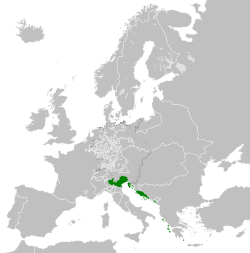Venice Republic
| Most Serene Republic of Venice | ||||||||||||||
|
||||||||||||||
|
||||||||||||||
|
The Republic of Venice in 1789
|
||||||||||||||
| Capital |
Eraclea (697–742) Malamocco (742–810) Venice (810–1797) |
|||||||||||||
| Languages | Latin, Venetian, Italian | |||||||||||||
| Government | parliamentary merchant republic with elective monarchistic features. | |||||||||||||
| Doge | ||||||||||||||
| • | 697–717 (first) | Paolo Lucio Anafestoa | ||||||||||||
| • | 1789–1797 (last) | Ludovico Manin | ||||||||||||
| Legislature | Great Council | |||||||||||||
| • | Upper Chamber | Senate | ||||||||||||
| • | Lower Chamber | Council of Ten | ||||||||||||
| Historical era | Middle Ages - Early modern period | |||||||||||||
| • | Established1 | 697 | ||||||||||||
| • | Golden Bull of Alexios I |
1082 |
||||||||||||
| • | Fourth Crusade | 1202-04 | ||||||||||||
| • | Battle of Lepanto | 1571 | ||||||||||||
| • | Treaty of Leoben | 17 April 1797 | ||||||||||||
| • | Treaty Campo Formio | 18 October 1797 | ||||||||||||
| Currency |
Venetian ducat Venetian lira |
|||||||||||||
|
||||||||||||||
| Today part of |
|
|||||||||||||
| a. ^ Paolo Lucio Anafesto is traditionally the first Doge of Venice, but John Julius Norwich suggests that this may be a mistake for Paul, Exarch of Ravenna, and that the traditional second doge Marcello Tegalliano may have been the similarly named magister militum to Paul. Their existence as doges is uncorroborated by any source before the 11th century, but as Norwich suggests, is probably not entirely legendary. Traditionally, the establishment of the Republic is, thus, dated to 697. | ||||||||||||||
The Republic of Venice (Italian: Repubblica di Venezia; Venetian: Repùblica Vèneta), or traditionally known as the Most Serene Republic of Venice (Italian: Serenissima Repubblica di Venezia; Venetian: Serenìsima Repùblica Vèneta), was a state originating from the lagoon communities in the area of Venice, now northeastern Italy. It existed from the late seventh century AD until 1797. Although it had a long history of war and conquest, the republic's modern reputation is chiefly based on its status as an economic and trading power.
It was formally known as the Most Serene Republic of Venice (Italian: Serenissima Repubblica di Venezia, Venetian: Serenìsima Repùblica Vèneta, or Venetian: Repùblica de Venesia) and is often referred to as La Serenissima, in reference to its title as one of the "Most Serene Republics".
The winged Lion of St. Mark, which had appeared on the Republic's flag and coat of arms, is still featured in the red-yellow flag of the city of Venice (which has six tails, one for each sestier of the city), in the coat of arms of the city and in the yellow-red-blue flag of Veneto (which has seven tails representing the seven provinces of the region).
The winged lion also appears in the naval ensign of the Italian Republic, alongside the coat of arms of three other medieval Italian maritime republics (Genoa, Pisa, and Amalfi), as well as the Golden Lion, awarded at the Venice Film Festival, and in the insignia of the Assicurazioni Generali insurance company.
...
Wikipedia



